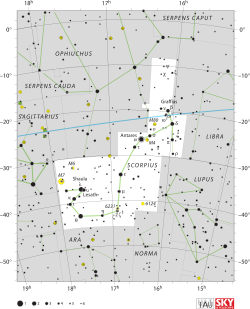| Observation data Epoch J2000.0 Equinox J2000.0 | |
|---|---|
| Constellation | Scorpius |
| Right ascension | 16h 15m 37.27028s[1] |
| Declination | –08° 22′ 09.9821″[1] |
| Apparent magnitude (V) | 5.503[2] |
| Characteristics | |
| Spectral type | G2 Va[3] |
| U−B color index | +0.18[4] |
| B−V color index | +0.64[4] |
| Variable type | Sun-like[5] |
| Astrometry | |
| Radial velocity (Rv) | 11.71±0.12[1] km/s |
| Proper motion (μ) | RA: 232.230 mas/yr[1] Dec.: −495.378 mas/yr[1] |
| Parallax (π) | 70.7371 ± 0.0631 mas[1] |
| Distance | 46.11 ± 0.04 ly (14.14 ± 0.01 pc) |
| Absolute magnitude (MV) | 4.77[2] |
| Details[6] | |
| Mass | 1.01±0.02 M☉ |
| Radius | 1.007±0.011 R☉ |
| Luminosity | 1.043±0.005 L☉ |
| Surface gravity (log g) | 4.437±0.013 cgs |
| Temperature | 5,817±4[7] K |
| Metallicity [Fe/H] | 0.06±0.03 dex |
| Rotation | 22.7±0.5 d[8] |
| Age | 2.9±0.5[9] Gyr 5.64 or 7.18[7] Gyr |
| Other designations | |
| Database references | |
| SIMBAD | data |
| Exoplanet Archive | data |
18 Scorpii is a solitary star located at a distance of some 46.1 light-years (14.13 parsecs) from the Sun at the northern edge of the Scorpius constellation. It has an apparent visual magnitude of 5.5,[2] which is bright enough to be seen with the naked eye outside of urban areas. The star is drifting further away with a radial velocity of +11.6.[2]
18 Scorpii has some physical properties in common with the Sun, a G-type star. Cayrel de Strobel (1996) included it in her review of the stars most similar to the Sun,[10] and Porto de Mello & da Silva (1997) identified it as a younger solar twin.[11][12] Some scientists therefore believe the prospects for life in its vicinity are good.
- ^ a b c d e Cite error: The named reference
GaiaDR3was invoked but never defined (see the help page). - ^ a b c d Cite error: The named reference
aaa418_989was invoked but never defined (see the help page). - ^ Cite error: The named reference
Keenan1989was invoked but never defined (see the help page). - ^ a b c Cite error: The named reference
SIMBADwas invoked but never defined (see the help page). - ^ Cite error: The named reference
aj138_1_312was invoked but never defined (see the help page). - ^ Cite error: The named reference
Karovicovawas invoked but never defined (see the help page). - ^ a b Cite error: The named reference
Bazot2018was invoked but never defined (see the help page). - ^ Cite error: The named reference
baas42_333was invoked but never defined (see the help page). - ^ "Identification of oldest solar twin may help locate rocky exoplanets". NASA. August 28, 2013. Retrieved 2020-11-10.
- ^ Cite error: The named reference
aar7_3_243was invoked but never defined (see the help page). - ^ "The life cycle of a Sun-like star (annotated)]". ESO. 28 August 2013. Retrieved 2020-11-10.
- ^ Cite error: The named reference
apj482_2_L89was invoked but never defined (see the help page).
